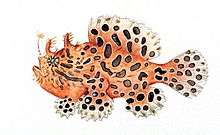Blenniiformes
Blenny (from the Greek ἡ βλέννα and τό βλέννος, mucus, slime) is a common name for a type of fish. The term is ambiguous, having been applied to several families of percomorph marine, brackish, and some freshwater fish sharing similar morphology and behaviour. Six families are considered "true blennies", all grouped together under the order Blenniiformes; its members are referred to as blenniiformids. About 151 genera and nearly 900 species have been described within the order. The order was formerly classified as a suborder of the Perciformes but the 5th Edition of Fishes of the World divided the Perciformes into a number of new orders and the Blenniiformes were placed in the percomorph clade Ovalentaria alongside the such taxa as Cichliformes, Mugiliformes and Gobiesociformes.[1]
| Blennies | |
|---|---|
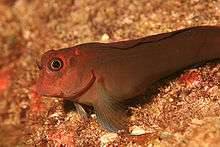 | |
| Ophioblennius steindachneri | |
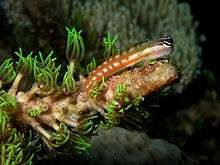 | |
| Ecsenius axelrodi from East Timor | |
| Scientific classification | |
| Kingdom: | Animalia |
| Phylum: | Chordata |
| Class: | Actinopterygii |
| (unranked): | Ovalentaria |
| Order: | Blenniiformes Bleeker, 1860 |
| Families | |
|
See text | |
Blenniformids are generally small fish-only occasionally reaching lengths up to 55 cm-, with elongated bodies (some almost eel-like), and relatively large eyes and mouths. Their dorsal fins are often continuous and long; the pelvic fins typically have a single embedded spine and are short and slender, situated before the pectoral fins. The tail fin is rounded. The blunt heads of blenniiformids often possess elaborate whisker-like structures called cirri. As generally benthic fish, blenniiformids spend much of their time on or near the sea floor; many are reclusive and may burrow in sandy substrates or inhabit crevices in reefs, the lower stretches of rivers, or even empty mollusc shells. Some blennies, otherwise known as "rock-hoppers", leap from the water onto rocks in order to reach other pools.[2][3][4][5][6]
True blennies are widely distributed in coastal waters, often abundant and easily observed which has made them the subject for many studies of ecology and behaviour. Two of the families, the Blennidae and the Tripterygiidae have global distributions, the Clinidae have a mainly temperate distribution and the remaining three families are largely Neotropical. This distribution makes these fish ideal subjects for studies of biogeography. It is thought that the splitting of the Tethys Sea by the formation of the Isthmus of Panama combined with Pliocene warming of the climate may have been important factors influencing the evolution and biogeography of the Blenniiformes.[7]
These fish are superficially quite similar to members of the goby and dragonet families, as well as several other unrelated families whose members have occasionally been given the name "blenny". Many blennies demonstrate mimicry of other species, such as Aspidontus taeniatus. This mimicry allows the blenny to get up close to fish that would normally let A. taeniatus, a cleaner wrasse, clean them. The blenny then takes nips or larger bites out of the unsuspecting fish. There are two genera of blennies that demonstrate Batesian mimicry- Ecsenius and Plagiotremus.[2][3][4][5][6]
As far as predation, blennies depend on a secretive lifestyle, hiding on the sea floors in shallow water, with cryptic coloration.[6]
Venom
For protection, there is only one genus that is truly venomous and that is Meiacanthus. These fish can inject venom from their mandibular, hollow fangs.[8] They have venom that contains the opioid-like enkephalin, phospholipase, and neuropeptide Y.[9]
Blenny Lineages
The six "true blenny" families are:[1][10]
- Blenniidae Rafinesque, 1810 - combtooth blennies, including the sabre-toothed blennies
- Chaenopsidae Gill, 1865 - pikeblennies, tubeblennies and flagblennies
- Clinidae Swainson, 1839 - clinids, including the giant kelpfish
- Dactyloscopidae Gill, 1859 - sand stargazers
- Labrisomidae Clark Hubbs, 1952
- Tripterygiidae Whitley, 1931 - threefin blennies
Timeline of genera

.jpg) Salarias sinuosus, the Fringelip Blenny
Salarias sinuosus, the Fringelip Blenny- Blenny hiding in a hole near Gilli Lawa Laut, Indonesia
 Tasmanian Blenny in Port Noarlunga, South Australia
Tasmanian Blenny in Port Noarlunga, South Australia
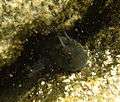

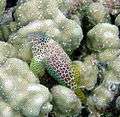
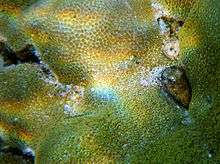 BulletHead RockSkipper in Kona
BulletHead RockSkipper in Kona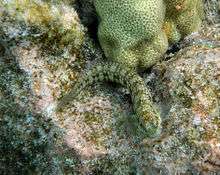 Marbled Blenny, Entomacrodus marmoratus in Kona
Marbled Blenny, Entomacrodus marmoratus in Kona
References
- J. S. Nelson; T. C. Grande; M. V. H. Wilson (2016). Fishes of the World (5th ed.). Wiley. p. 348. ISBN 978-1-118-34233-6.
- Allen, G (1994). Fishes of the Tropical Eastern Pacific. University of Hawaii Press.
- Böhlke, J., C. Chaplin. 1994. Fishes of the Bahamas and Adjacent Tropical Waters. Wynnewood, Pa: Published for the Academy of Natural Sciences of Philadelphia by Livingston.
- Helfman, G., B. Collete, D. Facey. 1997. The Diversity of Fishes. Malden, MA: Blackwell.
- Moyle, P., J. Cech. 2000. Fishes: An Introduction to Ichthyology – fourth edition. Upper Saddle River, NJ: Prentice-Hall.
- Springer, V. 1994. Blennies. Pp. 214-217 in W Eschmeyer, J Paxton, eds. Encyclopedia of Fishes – second edition. San Diego, CA: Academic Press.
- Hsiu-Chin Lin & Philip A Hastings (2013). "Phylogeny and biogeography of a shallow water fish clade (Teleostei: Blenniiformes)". BMC Evolutionary Biology. 13 (210): 210. doi:10.1186/1471-2148-13-210. PMC 3849733. PMID 24067147.
- Wheeler, A. 1985. The World Encyclopedia of Fishes. London: Macdonald.
- Losey GS. 1972. Predation protection in the poison-fang blenny, Meiacanthus atrodorsalis, and its mimics, Ecsenius bicolor and Runula laudandus (Blenniidae). Pac Sci 26(2): 129-139.
- Richard van der Laan; William S. Eschmeyer & Ronald Fricke (2014). "Family-group names of Recent fishes". Zootaxa. 3882 (2): 001–230. doi:10.11646/zootaxa.3882.1.1. PMID 25543675. S2CID 31014657.
- "Blennioidei". Integrated Taxonomic Information System. Retrieved 4 April 2008.
- Sepkoski, Jack (2002). "A compendium of fossil marine animal genera". Bulletins of American Paleontology. 364: 560. Archived from the original on 2009-02-20. Retrieved 2011-05-19.
